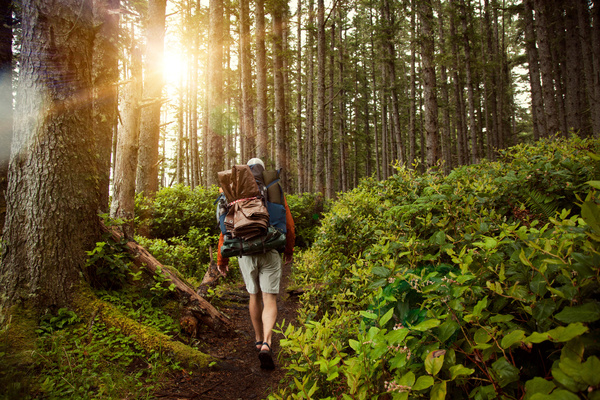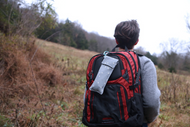How to Stay Hydrated While Hiking — Your Guide to Comfort
Posted by Krista Eickmann on 29th Nov 2023
There's no better way to immerse yourself in nature than hiking — it's meditation, education, and exercise rolled up into one. For some, a simple day hike reminds them of the natural world's grandeur, while others are drawn to the challenge of longer hikes like the Appalachian Trail.
No matter how long your hike, you'll need to figure out how to stay hydrated for health and comfort. Good hydration inevitably leads to peeing!
For hikers who can't stand to pee, this causes problems on a hike where there may be bugs, poison ivy, cold winds, or painful knees getting in the way of squatting. Enter the pStyle, a simple device that allows you to pee standing up, and you'll be peeing in comfort and style.

The Science of Hydration
Water is essential for the human body to regulate its temperature (very important on a hot day!), lubricates the joints to keep you moving, transports nutrients and oxygen to your muscles, and carries waste products away. Hikers need to stay hydrated to keep their bodies moving.
When to Drink
Many hikers drink according to thirst; after all, that's your body's mechanism for telling you it needs more water. Others find it helpful to set a hydration timer to go off every 20 minutes.
With a pStyle, there's no need to restrict water to avoid uncomfortable situations, and it's easy to monitor the color of your urine for proper hydration. It should be a light straw color. If it's too dark, stop and drink more — if it's clear, you can drink a bit less. Drink in smaller sips so your body can best absorb the water.
What Dehydration Looks Like
Staying hydrated can be challenging when you're out on the trail. Early signs of dehydration include fatigue, thirst, and increased body temperature and pulse. Urine will become darker colored and stronger smelling.
As dehydration progresses, a person can show signs of the "umbles": stumbles, mumbles, fumbles, and grumbles. If you notice clumsiness, slurred speech, slow reaction time, and a change in attitude, the dehydration might be serious.
For hikers, these issues affect more than athletic performance. You're more likely to get injured or lost if you are dehydrated. The benefits of staying hydrated include returning to the trailhead safely and in one piece.
Peeing and Dehydration
Some hikers — especially women, trans men, and gender non-conforming people — might lessen their water intake to avoid peeing on the side of the trail. If you have to drop your pants to pee, social pressure (not to mention fear of poison ivy) can be compelling.
The ability to pee standing up without removing clothing helps hikers to keep drinking water. That's one big reason we recommend the pStyle!
Day Hikers
If you’re not camping or making a multi-day trek, the best way to stay hydrated is to carry your water.
Carrying Water
There are many ways to carry water. Water bottles come in all shapes and sizes — BPA-free plastic, metal, insulted, with or without straws. Most day packs designed for hikers include external pouches to hold water bottles.
Many hiker's packs now include a water reservoir, a soft plastic bag set inside the pack with a straw that snakes over your shoulder. Water is heavy, and this design distributes its weight, making it easier to carry.
How Much Water Should I Bring?
You might wonder how much water you need to stay hydrated. Hikers usually need to carry their water, so it's essential to consider how much you'll need ahead of time.
A general rule is to bring a pint of water for every hour of moderate hiking and a quart per hour for strenuous or hot-weather hiking. You'll need to add another 1.5 quarts to your daily water intake at higher elevations.
Prehydration
Athletes often "prehydrate" before exercise, hydrate during exercise, and rehydrate afterward. Make sure you're not dehydrated before you set out on your hike.
If you carry an STP device like the pStyle on your hike, you won't need to worry about holding it until you return.
Long Distance Hikers
Hiking long distances presents different challenges. Staying hydrated means you'll need to carry at least some water, but the big challenge is finding water sources along the trail and making that water safe to drink.
In addition to the bottle or reservoir you'll carry on the trail, some hikers use collapsible two-and-a-half-gallon water bags for processing water at their campsite, for drinking, cooking, and dishes.
Water purification is critical as you plan how to stay hydrated on your trek. Open water sources like creeks often carry microorganisms like E. coli or Giardia lamblia that can make humans sick.
Boiling water for at least one minute, or three to five minutes at high altitudes, is a reliable way to kill microorganisms, but it is time-consuming and requires fuel and bulky equipment.
Water filters have many advantages: some are hand-operated, others filter by gravity, and some integrate into bottles. Make sure you buy reputable brands and replace old filters before you go.
Lastly, remember your stand-to-pee device! A pStyle on the trail will make staying hydrated a thousand times easier.
Winter Hikers
Most people associate hydration with hot, sweaty summer days. Hydration is vital in winter, too. Here are a few special considerations for winter hikers.
Keep your water bottle or reservoir from freezing by keeping it insulated or closer to your body. Blow air through the water lines after drinking. Even better, bring hot soup in your insulated bottle!
If you're staying hydrated, you'll have to pee sooner or later, and who wants to drop trou in freezing weather? STP devices like the pStyle make it possible to pee standing up without removing your clothing, provided that your pants or coveralls have a crotch-level zipper or that you can lower the waistband.
The pStyle
Standing to pee makes a significant difference for hikers. If you've got a pStyle, you can stay fully hydrated and let go of all the worries of pulling your pants down in the woods.
It's not just the trail that's difficult for peeing, either. Stand-to-pee devices make it easier to navigate many situations hikers encounter. Why squat over a pit toilet if you don't have to? Do you want to use the port-a-potties at the trailhead? What if the park restrooms are locked?
The pStyle takes the stress out of peeing when you need to.
Stay Hydrated and Have Fun!
Drink more water, and heck — go ahead and pee as often as you like! If you know how to stay hydrated and you can pee comfortably, the rest of the hike is all fun.
Want to know more about the pStyle? Visit our website to check out the pStyle's many colors, and while you're there, check out the handsome pCase designs you can clip to your belt or hiking pack.
If you have questions, message us on our site's contact page.


